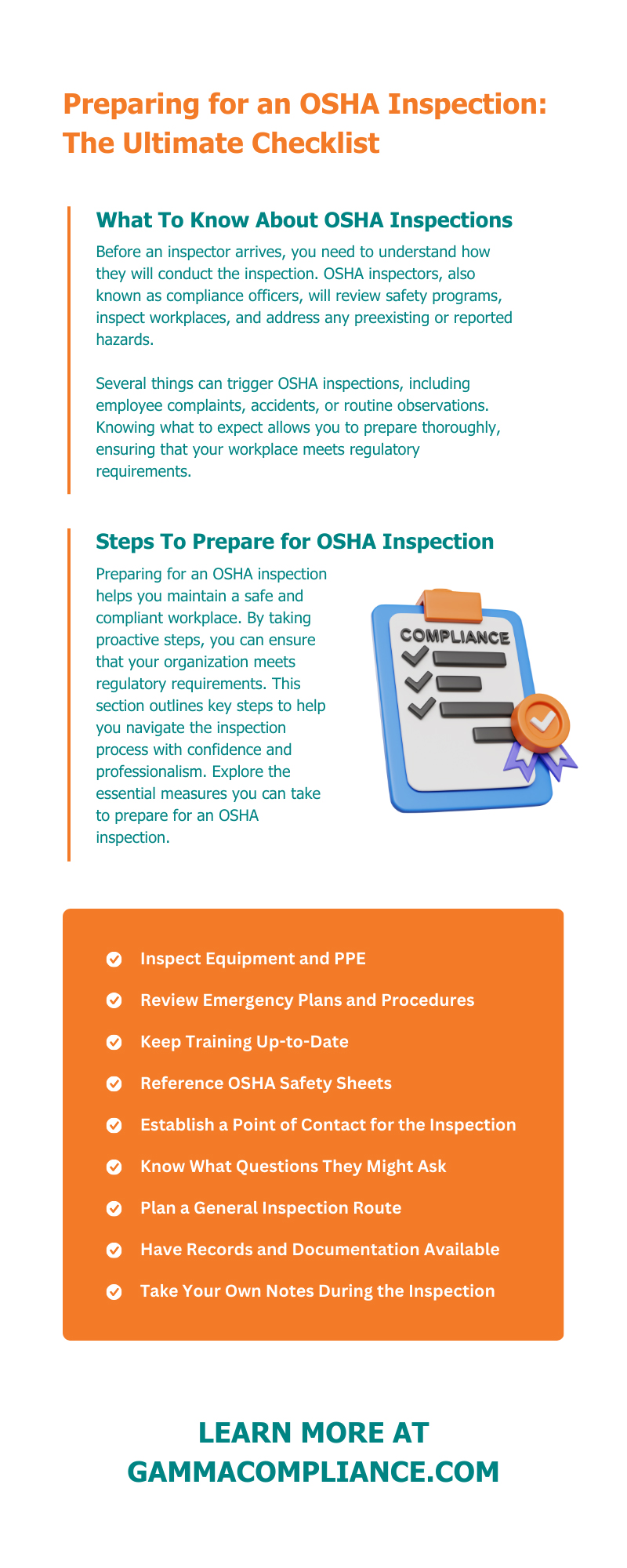Workplace safety is a priority for every business, and meeting Occupational Safety and Health Administration (OSHA) standards maintains a safe and compliant environment. OSHA inspections are part of complying with OSHA standards and identifying safety risks in your business. Proper preparation for an OSHA inspection ensures compliance and protects your employees and your business from potential penalties. This guide provides a comprehensive checklist to help safety managers and business owners prepare for an OSHA inspection.
What To Know About OSHA Inspections
Before an inspector arrives, you need to understand how they will conduct the inspection. OSHA inspectors, also known as compliance officers, will review safety programs, inspect workplaces, and address any preexisting or reported hazards.
Several things can trigger OSHA inspections, including employee complaints, accidents, or routine observations. Knowing what to expect allows you to prepare thoroughly, ensuring that your workplace meets regulatory requirements.
Steps To Prepare for OSHA Inspection
Preparing for an OSHA inspection helps you maintain a safe and compliant workplace. By taking proactive steps, you can ensure that your organization meets regulatory requirements. This section outlines key steps to help you navigate the inspection process with confidence and professionalism. Explore the essential measures you can take to prepare for an OSHA inspection.
Inspect Equipment and PPE
Inspecting all equipment and personal protective equipment (PPE) is one of the most important steps of readiness. Machines, tools, and equipment should be in good condition, meet safety standards, and have proper labeling. If you notice any equipment that’s broken or malfunctioning, repair or remove it immediately. When inspecting PPE, ensure that items such as gloves, helmets, goggles, and ear protection function properly and that they are present for all relevant tasks. Verify that employees are aware of proper usage guidelines and have access to the necessary equipment.
Regular inspections of tools and machinery prepare you for an OSHA visit and help you maintain a safe environment on a daily basis. Conduct routine checks to prevent accidents caused by faulty equipment or defective protective gear.
Review Emergency Plans and Procedures
Emergency preparation is a key focus area during OSHA inspections. Businesses must have clear, comprehensive plans for handling emergencies such as fires, chemical spills, or natural disasters. To ensure quick and safe evacuation, businesses must clearly mark emergency routes and keep them unobstructed. Additionally, review your procedures for addressing incidents and verify that employees understand their roles in various emergency scenarios.
Inspectors will evaluate your emergency action plans to ensure they align with OSHA standards. Training employees regularly on these procedures enhances their effectiveness and demonstrates your commitment to workplace safety.
Keep Training Up-to-Date
Employee safety training is essential for maintaining compliance. OSHA requires training programs tailored to specific workplace hazards and job roles. Employees must be knowledgeable about how to operate equipment safely, use PPE, and respond to emergencies. Keep your training materials up-to-date and easily accessible.
Everyone on your team should undergo regular training procedures. Include both new hires and long-term employees in ongoing training sessions to reinforce safety policies. Adequate training fulfills OSHA requirements and empowers employees to maintain a safe working environment.
Reference OSHA Safety Sheets
Your business should supply safety data sheets (SDS), previously known as material safety data sheets (MSDS), for any hazardous chemicals that employees use in your workplace. These sheets provide detailed information about the properties, risks, and handling of specific substances. OSHA inspectors often review SDS documentation to evaluate compliance with Hazard Communication Standards.
Ensure all chemicals in the workplace feature proper labels and that employees understand how to access and use SDS. Having this information readily available shows your commitment to transparency and safety.
Establish a Point of Contact for the Inspection
Designate a point of contact who will accompany the OSHA inspector during their visit. Choose an individual who thoroughly understands safety policies, procedures, and documentation. Having a knowledgeable and prepared representative ensures smooth communication and addresses any concerns that may arise during the inspection.
The designated contact should be prepared to answer questions, provide requested documentation, and explain safety practices. Their role creates a positive impression of your organization’s commitment to compliance.
Know What Questions They Might Ask
OSHA inspectors may ask questions to verify compliance and employee awareness. These questions could cover topics such as safety protocols, emergency plans, hazard communication, and employee training. Employees should know how to answer questions confidently and accurately.
Conduct mock inspections to familiarize your team with potential questions. This exercise prepares employees and identifies areas that may need additional attention before the actual inspection.
Plan a General Inspection Route
Creating a logical inspection route through your workplace ensures that the inspection will review key areas without confusion or delay. Identify high-risk areas, such as manufacturing zones or storage areas for hazardous materials, and conduct your own inspections.
A structured route also allows you to address potential problem areas proactively, minimizing the likelihood of citations. Being organized demonstrates a high level of preparedness and professionalism to the inspector.
Have Records and Documentation Available
Accurate and up-to-date documentation promotes a successful OSHA inspection. This includes training records, injury and illness logs, hazard assessments, and equipment maintenance records. Organize these documents logically and keep them easily accessible for inspection. Proper documentation reinforces your compliance with OSHA regulations and reflects your proactive approach to safety management.
Take Your Own Notes During the Inspection
During the inspection, take detailed notes of the inspector’s observations and comments. This documentation provides valuable insights into areas that need improvement and helps you address issues effectively. Recording the inspection process also ensures that you have an accurate reference for future audits or follow-ups.
Your notes can become a valuable part of your continuous improvement strategy. Use them to identify trends, plan corrective actions, and track your progress over time.
What To Do After the Inspection
After the inspection, review the findings thoroughly, including any citations or recommendations. Develop a clear plan to address areas the inspector may have marked up and implement corrective actions promptly. Document your response and follow up with OSHA as required.
Taking post-inspection steps seriously ensures your workplace continues to improve and meet regulatory standards over time. Use the experience as an opportunity to strengthen your safety program and mitigate potential risks.
Where To Find OSHA Resources To Prepare
OSHA and trusted compliance partners provide extensive resources to help businesses prepare for inspections. Gamma Compliance Solutions offers a range of tools, guides, and training materials designed to simplify the compliance process. Our resources enable businesses to stay informed and confidently meet OSHA requirements.
Explore OSHA’s official website and Gamma Compliance Solutions to access comprehensive information tailored to your industry. For example, you can find an OSHA program manual for medical facilities and more, so browse today to find the proper resources for your branch of the health-care industry.
Ensure Your Workplace Is OSHA-Ready
Preparing for an OSHA inspection doesn’t have to be overwhelming. By following this checklist of ways to prepare for an OSHA inspection, safety managers and business owners can take proactive steps to ensure compliance and protect their teams. From inspecting equipment and training employees to maintaining accurate documentation, every step contributes to a safer workplace.
If you’re ready to enhance your readiness, visit Gamma Compliance Solutions for expert guidance and resources. Use our OSHA resources to start preparing today and create a culture of safety and compliance within your organization.



